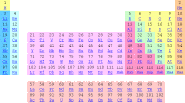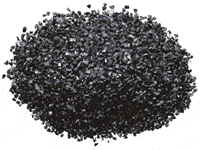


Carbon
 There are several allotropes of the element carbon. The
most common ones are amorphous carbon and graphite. The picture shows amorphous
carbon. Diamond is another, very
expensive, form of carbon and fairly recently the so-called fullerenes, C60,
and nano-tubes were discovered. For the home lab, only amorphous carbon and
graphite are interesting.
There are several allotropes of the element carbon. The
most common ones are amorphous carbon and graphite. The picture shows amorphous
carbon. Diamond is another, very
expensive, form of carbon and fairly recently the so-called fullerenes, C60,
and nano-tubes were discovered. For the home lab, only amorphous carbon and
graphite are interesting.
Amorphous carbon is a black solid, which can be made by heating/charring wood, it can also be purchased at photography raw chemical stores as carbon black. Amorphous carbon can be interesting for some dry-chemical experiments, mostly of pyrotechnic nature. Elementary carbon does not have any interesting aqueous chemistry. The element is very inert in the temperature range for liquid water.
Graphite is very interesting for the home lab. It is a black solid, which conducts electricity fairly well in two directions, while in directions, perpendicular on these two directions, its conductivity is much lower. This can be explained by the structure of graphite. Elementary carbon is very inert and this property is very beneficial in many electrolysis experiments. A graphite anode withstands many highly oxidative conditions. It does not easily dissolve, as most metal electrodes do. Graphite rods can be ordered online at science/hobby supply houses, but they can also be taken from old zinc-graphite batteries. Alkali- and lithium batteries do not have a graphite rod inside. Beware, however, that taking out graphite rods from old batteries is a very messy and dirty task. Pencils also contain thin graphite rods and these can be used with success in many experiments as well.
![]()
There are many many compounds of carbon, which can be interesting for the home lab. All organic compounds contain carbon. Besides the organic ones, there are just a few inorganic compounds, containing carbon, which are interesting and accessible for a home lab.
- sodium carbonate, Na2CO3·xH2O
- sodium bicarbonate, NaHCO3
- ammonium carbonate, (NH4)2CO3
- sodium percarbonate, Na2[CO2(O2)]·H2O·½H2O2
- sodium thiocyanate, NaSCN
- sodium cyanide, NaCN
- calcium carbide, CaC2
- carbon dioxide, CO2
- carbon monoxide, CO
![]() Sodium carbonate is available as anhydrous salt (x = 0), monohydrate (x = 1) and
decahydrate (x = 10). The decahydrate is the standard crystalline soda,
available at any supermarket or drugstore. The decahydrate tends to loose water
and the crystals fall apart. The anhydrous form tends to pick up water. The
monohydrate is the most stable form on storage. As long as precise measurement
of quantities is not really important, any form is suitable. Carbonates can be
used as moderately strong bases. They also can be used to prepare carbon dioxide
gas, simply by adding some acid. Many transition metal salts produce interesting
precipitates with carbonates, although some of them produce so called basic
carbonates (contain hydroxide ions in the precipitate) and carbon dioxide or
bicarbonate.
Sodium carbonate is available as anhydrous salt (x = 0), monohydrate (x = 1) and
decahydrate (x = 10). The decahydrate is the standard crystalline soda,
available at any supermarket or drugstore. The decahydrate tends to loose water
and the crystals fall apart. The anhydrous form tends to pick up water. The
monohydrate is the most stable form on storage. As long as precise measurement
of quantities is not really important, any form is suitable. Carbonates can be
used as moderately strong bases. They also can be used to prepare carbon dioxide
gas, simply by adding some acid. Many transition metal salts produce interesting
precipitates with carbonates, although some of them produce so called basic
carbonates (contain hydroxide ions in the precipitate) and carbon dioxide or
bicarbonate.
![]() Sodium bicarbonate is a white fine powder, which is non-toxic and non-corrosive.
It is a very convenient source for carbon dioxide. Even addition of a weak acid,
like vinegar, already produces a lot of carbon dioxide. Sodium bicarbonate is
one of the few chemicals, with which children can play around, without
introducing serious health risks. Besides that it is very cheap and available in
every drugstore. It can be very challenging for children to play with the stuff
and see it fizzle and bubble. On this site,
a set of nice child-safe experiments
is described, for which sodium bicarbonate is the main active ingredient.
Sodium bicarbonate is a white fine powder, which is non-toxic and non-corrosive.
It is a very convenient source for carbon dioxide. Even addition of a weak acid,
like vinegar, already produces a lot of carbon dioxide. Sodium bicarbonate is
one of the few chemicals, with which children can play around, without
introducing serious health risks. Besides that it is very cheap and available in
every drugstore. It can be very challenging for children to play with the stuff
and see it fizzle and bubble. On this site,
a set of nice child-safe experiments
is described, for which sodium bicarbonate is the main active ingredient.
![]() Ammonium carbonate is a white powder with a strong smell of ammonia. It
dissolves easily in water and when left in the open air, it completely
vaporizes, decomposing to carbon dioxide, water and ammonia. It can be used as
the basis for production of many ammonium salts. With certain transition metals
(most notably cobalt) very interesting complexes can be formed, in which both
ammonia molecules and carbonate ions are coordinated to the central metal ion.
It can be obtained at many drugstores and through photography raw chemical
suppliers.
Ammonium carbonate is a white powder with a strong smell of ammonia. It
dissolves easily in water and when left in the open air, it completely
vaporizes, decomposing to carbon dioxide, water and ammonia. It can be used as
the basis for production of many ammonium salts. With certain transition metals
(most notably cobalt) very interesting complexes can be formed, in which both
ammonia molecules and carbonate ions are coordinated to the central metal ion.
It can be obtained at many drugstores and through photography raw chemical
suppliers.
![]() Sodium percarbonate usually is not used because of its carbonate-content, but
because of the presence of a peroxo-group in the compound. For this reason, this
compound is discussed on the page about oxygen.
Sodium percarbonate usually is not used because of its carbonate-content, but
because of the presence of a peroxo-group in the compound. For this reason, this
compound is discussed on the page about oxygen.
![]() Sodium thiocyanate (or the potassium or ammonium salt) is a very interesting
compound, which is available at photography raw chemical suppliers. It is cheap
and can be used in many experiments. Sodium thiocyanate is a deliquescent white
solid. Thiocyanate forms colorful complexes with many transition metals (most
notably copper, gold, iron, cobalt), but it also forms highly colored compounds
with non-metallic compounds of unknown nature. In the riddles section of this
site two interesting examples are given (example1,
example2).
Sodium thiocyanate (or the potassium or ammonium salt) is a very interesting
compound, which is available at photography raw chemical suppliers. It is cheap
and can be used in many experiments. Sodium thiocyanate is a deliquescent white
solid. Thiocyanate forms colorful complexes with many transition metals (most
notably copper, gold, iron, cobalt), but it also forms highly colored compounds
with non-metallic compounds of unknown nature. In the riddles section of this
site two interesting examples are given (example1,
example2).
![]() Sodium cyanide (or the potassium salt) is a moderately interesting
compound, which is available at a few photography raw chemical suppliers. It is
fairly cheap
and can be used in many experiments. Sodium cyanide is a hygroscopic white
solid. Cyanide forms many complexes with almost all transition metals.
Sodium cyanide (or the potassium salt) is a moderately interesting
compound, which is available at a few photography raw chemical suppliers. It is
fairly cheap
and can be used in many experiments. Sodium cyanide is a hygroscopic white
solid. Cyanide forms many complexes with almost all transition metals.
![]()
![]() However, the use of
cyanides is not recommended for the beginning home chemist. Cyanides are very
poisonous and can easily kill you. When acids are added, then the extremely
poisonous hydrogen cyanide is formed, which at high concentrations easily
escapes from the liquid in which it is formed. Cyanides do not have a long-term
effect, however.
However, the use of
cyanides is not recommended for the beginning home chemist. Cyanides are very
poisonous and can easily kill you. When acids are added, then the extremely
poisonous hydrogen cyanide is formed, which at high concentrations easily
escapes from the liquid in which it is formed. Cyanides do not have a long-term
effect, however.
![]() Calcium carbide is an interesting compound for the home lab. In its pure form it
is a white solid, but it is sold as 'carbid', which is a grey solid, containing
a few percent of impurities (mainly carbon and a small amount of phosphide).
When carbid is put in water, then the colorless gas ethyne, also known as
acetylene, C2H2, is produced. This is a relatively
non-toxic, but very flammable and quite reactive gas, which can be used for
several interesting experiments. The gas, produced from carbid, usually has a
bad smell. This is due to the presence of small amounts of phosphine, PH3.
Phosphine is very toxic, so it is best not to inhale too much of the gas,
produced by carbid and water.
Calcium carbide is an interesting compound for the home lab. In its pure form it
is a white solid, but it is sold as 'carbid', which is a grey solid, containing
a few percent of impurities (mainly carbon and a small amount of phosphide).
When carbid is put in water, then the colorless gas ethyne, also known as
acetylene, C2H2, is produced. This is a relatively
non-toxic, but very flammable and quite reactive gas, which can be used for
several interesting experiments. The gas, produced from carbid, usually has a
bad smell. This is due to the presence of small amounts of phosphine, PH3.
Phosphine is very toxic, so it is best not to inhale too much of the gas,
produced by carbid and water.
![]() Carbon dioxide can easily be prepared as a non-toxic, colorless and almost
odorless gas, by acidification of a carbonate or bicarbonate with acid.
Chemically speaking, carbon dioxide is not very interesting and it is rather
inert.
Carbon dioxide can easily be prepared as a non-toxic, colorless and almost
odorless gas, by acidification of a carbonate or bicarbonate with acid.
Chemically speaking, carbon dioxide is not very interesting and it is rather
inert.
![]() Carbon monoxide can be prepared by the home chemist with some difficulty from
oxalic acid and concentrated sulphuric acid. This procedure is highly
discouraged here.
Carbon monoxide can be prepared by the home chemist with some difficulty from
oxalic acid and concentrated sulphuric acid. This procedure is highly
discouraged here. ![]()
![]() The gas is colorless, odorless and very toxic. It may knock you out, without any
warning in advance. So, steer away from the use of carbon monoxide in the home
lab. It is much more dangerous to work with carbon monoxide than with e.g.
chlorine or hydrogen chloride gas, due to the lack of any warning.
The gas is colorless, odorless and very toxic. It may knock you out, without any
warning in advance. So, steer away from the use of carbon monoxide in the home
lab. It is much more dangerous to work with carbon monoxide than with e.g.
chlorine or hydrogen chloride gas, due to the lack of any warning.
Besides the compounds, mentioned above, there are many other compounds of carbon, which are interesting for the home lab. These are organic compounds. Some to name are:
- methanol
- ethanol
- propanol, iso-propanol
- acetone
- diethyl ether
- citric acid
- acetic acid and sodium acetate
- oxalic acid and potassium oxalate
- benzoic acid and sodium benzoate
- several compounds, used as photo developers, such as hydroquinone, metol, p-aminophenol
- chlorinated hydrocarbons, like trichloroethylene,
tetra, chloroform.

 Many of these
are carcinogens and they should be used with care and disposed of in a
proper way after performing the experiment. For the home lab these do not
add very much and frequently ligroin is a good alternative for these.
Many of these
are carcinogens and they should be used with care and disposed of in a
proper way after performing the experiment. For the home lab these do not
add very much and frequently ligroin is a good alternative for these. - ...